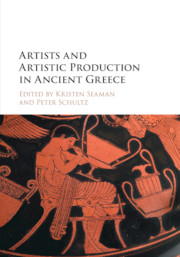Introduction: The Impersonality of Mosaic Production
In his introduction to Personal Styles in Greek Sculpture, J.J. Pollitt lays out the criteria we need to follow to reconstruct an ancient artist’s style. First, we need the availability of a large corpus of identifiable works; next, we need a deep familiarity with literary sources; and, finally, we need a solid stylistic history established by archaeological discoveries.1 For art historians or archaeologists interested in the intersection between personal styles and Hellenistic mosaics, however, these criteria prove to be a challenge, especially the first two. The work of very few individual mosaicists has been identified and only one practitioner, the artist Sosos who was active at Pergamon, is mentioned in the literary record, in Pliny’s brief history of mosaics (HN 36.184–189). Sosos’s most famous works, the asarotos oikos (Unswept Room) and drinking doves, are known only through copies.2 One of the best examples of the former is in Rome, and it bears the name of a different individual, Herakleitos. Only eight other pre-Imperial mosaics found at Mediterranean sites are inscribed; these inscriptions seem to be artist signatures (see Map 5.1). Two come from Delos. The others come from Athens, Pella, Thmuis, Pompeii, Segesta, and Euesperides. Of these, three have ethnics that identify individuals from Phoenician Arados ([Askle]piades, found at Delos), Samos (Dioskourides, found at Pompeii), and Alexandria ([D]ionysios of [He]rakleides, found at Segesta).3
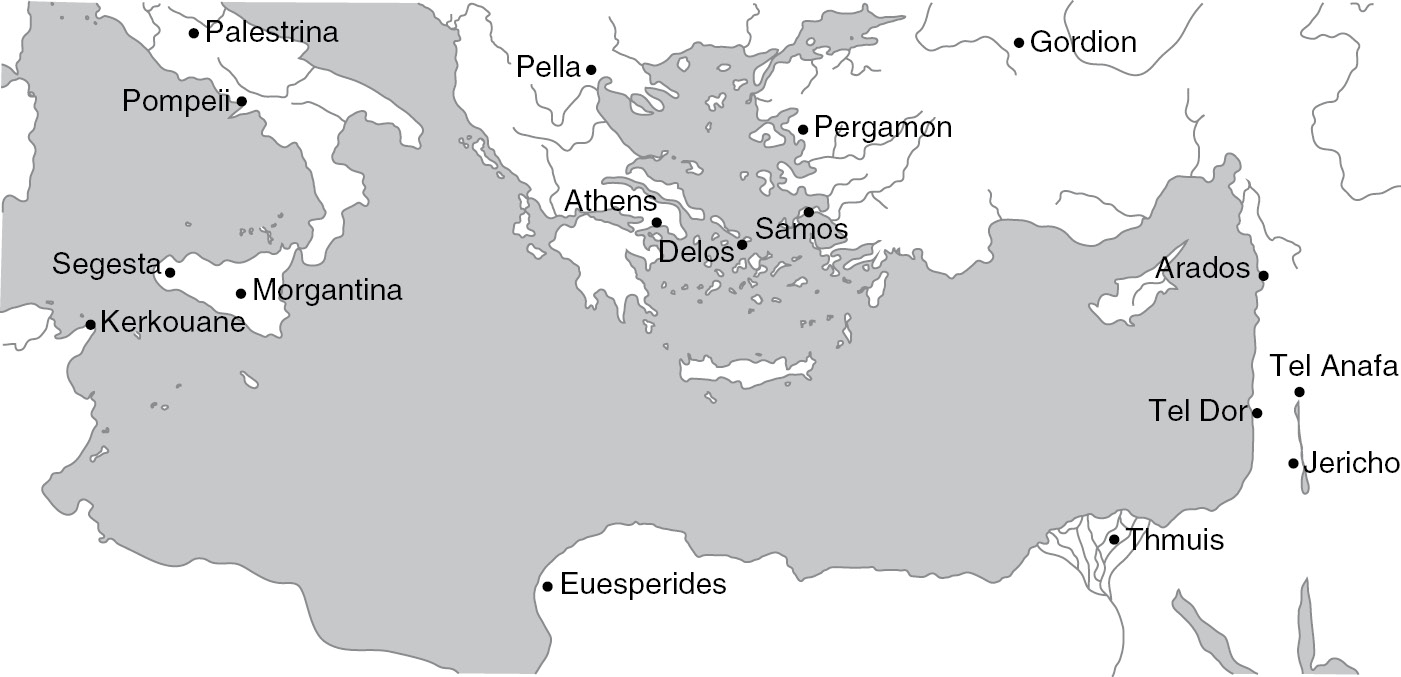
Map 5.1. Map of the Hellenistic Mediterranean.
A few features characterize the corpus of signatures in mosaic. All are written in Greek but at least one, belonging to Asklepiades, does not name a Greek. Two are on fourth-century pebble mosaics in Greece (Athens and Pella); the remainder is found on Hellenistic tessellated mosaics from outside the mainland. Most were found in, or near, royal or other major centers, with two exceptions from the west – Pompeii and Segesta, the Elymian capital in northwest Sicily – and another from the North African site of Euesperides in Libya. None of the ethnics matched its find spot. Dioskourides’s name appears twice on paired emblemata that may have been transported from elsewhere.4 In terms of content, the signatures seem to be simple statements of craftsmanship: Sophilos epoiei (“Sophilos made [me]”).5 With the exception of the pebble mosaic from Athens, all examples are found on mosaics of exceptionally high quality. Signatures do not guarantee originality, however, as demonstrated by Herakleitos’s asarotos oikos, and, of course, some of the finest picture mosaics ever produced were unsigned. Finally, the signatures were not valuable in themselves: the borders and trompe l’oeil inscription of Hephaistos in Palace V at Pergamon are all that remain of the original mosaic, the remainder having been cut away and carted off.6
The well-known business contract, Zenon papyrus 59665 (256–246 b.c.e.), provides our sole example of how Hellenistic decorative floors were arranged. The contract describes in detail the plan of mosaics for the tholoi of two baths, one for each sex, for a villa in Egyptian Philadelphia. The paradeigma (model) for the men’s tholos comes from a royal workshop; the basis for the woman’s tholos probably came from some other preexisting design.7 We cannot know how typical this contract was, but it does suggest that complex visual programs could be communicated in writing. The Zenon papyrus proves that the influence of royal workshops extended beyond the major centers to locations lacking resident craftsmen, in this case, from the tip of the Nile Delta into the Fayyum. In contrast to the passage from Pliny, the papyrus shows no interest in the individual artist.
Pollitt’s third criterion – a clear stylistic history – also remains somewhat elusive for the history of mosaics. It is a common practice to date mosaics on stylistic grounds, yet poor preservation, a reluctance to excavate below floors (and, in doing so, to remove or damage them), and modern mishandling mean that chronological certainty is lacking for many key works that might serve as good makers. Pompeii and Delos do have secure terminal dates for their mosaics, and excavation methods throughout the Mediterranean continue to improve. Continued and better excavation will provide indispensable chronological information that operates independently from assumptions about stylistic development; improved understanding of the distribution of iconographic themes, styles and compositions; insights into contexts and patrons; and a firmer grasp of techniques.8 From a few sites we have solid examples of mosaics dated entirely on archaeological grounds, as at Tel Anafa, for example (more on this later).9
Yet even in the best of circumstances, studies of iconography and even style, context, and patronage cannot always (or often) lead us to specific artists or allow us to identify hands within workshops or regions. One reason for this is frequent reuse of models, although exactly how this process worked is debated. If programs could be made to order, as documented by the Zenon papyrus, composition and context may better reflect predilections of the patron or popular types than individual artists. Another challenge to ascribing authorship is that emblemata could be transported complete, although the practice is also understood poorly.
Some sites were capable of supporting local mosaic workshops, at least for a time. The understanding of workshops is far from perfect, however, even at Alexandria and other locations where tessellated mosaics are numerous, such as Delos and Pompeii. The so-called Casa del Fauno workshop provides a good example.10 Paul Meyboom has argued for the existence of this workshop through a careful study of iconography, composition, and materials used in a group of fish mosaics from regions near Rome and the bay of Naples, especially Palestrina and Pompeii. To this group of fish mosaics Meyboom has added several others from Palestrina (including the Nile mosaic), where the workshop seems to have been active from ca. 120–110 b.c.e., and from the eponymous House of the Faun, which is the source of the greatest number of examples, that date from ca. 110 b.c.e.11 After 80 b.c.e., a decline is observed; post-50 b.c.e. only a few small-scale scenes with similar Nilotic-aquatic iconography are known. Soon workshop activity dies out altogether, the result of shifting tastes or, perhaps, the death of the founding master craftsmen.
There is much to think about in this reconstruction of the workshop’s life cycle. For starters, it appears that neither Palestrina nor Pompeii could support the workshop exclusively, although its attributed work is concentrated there. Demand was inconsistent. Meyboom notes that the surviving number of figural mosaics at Pompeii, one third of which were in the House of the Faun, could not have supported even one group of craftsmen active over a fifty-year period.12 There is no reason to assume that this workshop was stationed at Pompeii. It has been suggested that its home was Puteoli, a cosmopolitan and bustling location that might account also for the work’s apparent ties to Alexandria. A base at Puteoli would have been convenient for the receipt of commissions and export of emblemata.13
One drawback of Meyboom’s study, however, is that it relies on connoisseurship – a valuable tool, but one made especially difficult to employ when discussing the work of an unknown number of anonymous hands, all of which were using related models. Of course, models do not dictate the quality or appearance of the final product. For example, the two pomegranates seen in a detail of a mask and garland frieze from Tel Dor (Figs. 5.1–5.2) use a similar model with very different results: at least two hands were at work here, one of which (Fig. 5.2) was clearly less skilled. Paintings, manuscript illumination, and even sculpture could provide inspiration for mosaics; stock figures could be combined and recombined to create fresh compositions, which was how the Nilotic scenes attributed to the Casa del Fauno workshop were produced.14 Perhaps the offer of variations on a common theme was itself the attraction of the work.
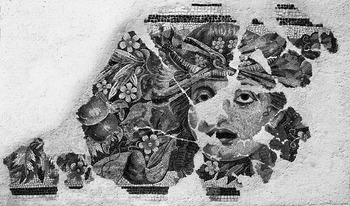
5.1. Mask mosaic from Tel Dor, Israel. Conservator Orna Cohen.
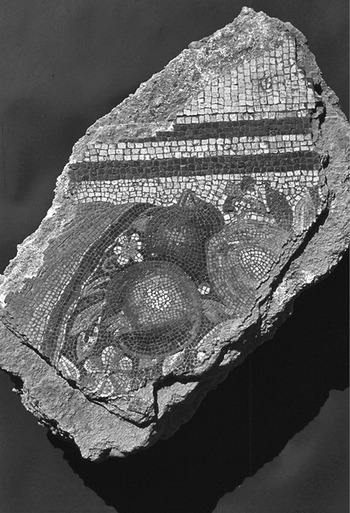
5.2. Garland mosaic fragment from Tel Dor, Israel.
As Meyboom rightly acknowledges, we cannot know whether these mosaics were made by the same workshop, by associated artists or workshops, or even by other unrelated artists drawing on the Casa del Fauno’s popular types; all are equally possible.15 We can deconstruct further: there is no concrete evidence of any such workshop, and we can imagine myriad alternate possibilities: former “apprentices” establishing new shops, local artists working on spec and reproducing types, etc. Mosaic does not lend itself to the confident attribution of artists. Nevertheless, the most readily available evidence of artistic activity comes from observation of reoccurring subjects, compositions, and styles. Such evidence supports equally the use of models and, judiciously applied, the presence of workshops. Presumably some Hellenistic era workshops existed outside Alexandria, and it seems impertinent to argue against them simply on principle.16 Both views are speculative.
Studies of technique offer more concrete evidence. Technique encompasses composition, use of models, and choice of materials. Its most indicative aspects are the ways in which individual tesserae were laid in different parts of the floor; the appearance of sinopia (guidelines), incisions, lead and terracotta strips; and the construction of the mortar beds or emblemata. Presumably, these practices were consistent within workshops.17 Some investigations, especially those of bedding construction, are better suited to fragmentary floors or require the partial destruction or removal of those that are in situ. There is a delicate balance between gathering precious information and preserving works as they are found. Other studies are noninvasive. The discovery of so-called “transitional” mosaics, which exhibit a combination of characteristics found in pebble, chip, or tessellated floors, has relied on close observation of surface features.18 In part the identification of regional styles has, too, as with the presence or absence of lead strips.19 Beyond regional trends we may someday identify workshops or even craftsmen, especially those that travelled, through a combination of approaches. Although the work of a good “apprentice” might be indistinguishable from a “master,” the identification of specific approaches to the mosaic craft encourages the comparison of tangible quantities.
The discussion of individual mosaicists cannot compare to what is known about sculptors, painters, or architects. We know of Sosos only because of Pliny. Without that passage, we might not associate the asarotos oikos with the drinking doves. Both would probably be attributed to popular models circulating in Italy, not to a great master who worked at Pergamon. We do not have, in the study of mosaicists, an example comparable to the sculptor Damophon, where original works and literary descriptions converge at Messene in a defined archaeological context.20 For ancient authors, mosaics fall into the category of anonymous craft, though it is important to recall the same may be true, on some level, for nearly the whole of ancient art, even works that were regularly signed by their makers.21 In “craft” genres, great masters are difficult to uncover.
Despite these limitations, Hellenistic picture mosaics played an important role in the development of the artistic and aesthetic sensibilities of the Hellenistic world that is worth attempting to recover. The remainder of this essay will show that traditional thinking about the origins, development, techniques, and artists involved in mosaic production has led to the false impression of mosaic as an especially Hellenic craft that developed in imitation of Greek painting. It argues that, on the one hand, Greek painting was only one of many sources from which mosaic drew, and, on the other hand, the association between picture mosaics, Greece, and Greeks is not especially strong. Mosaic production was in fact a widespread phenomenon that reveals a high degree of Mediterranean connectivity from at least the early Hellenistic era. This claim will be considered first by looking in-depth at two recently discovered picture mosaics from Hellenistic Palestine. The fragmentary state of these mosaics has allowed for close analysis of their technique, especially in their mortars, which has revealed – for the first time – the activity of a single travelling artist. From Palestine, we will return to the question of an artist’s individual identity by considering the context of the few signed mosaics with ethnics. Together with the Palestinian picture mosaics, these signatures offer proof of the innovation and mobility of ancient mosaicists and further contribute to the idea that mosaic was an art form that transcended the quasi-nationalistic identity it has been ascribed.
Craft Identity
The finest tessellated mosaics, especially those picture mosaics produced in the technique we refer to as opus vermiculatum, are understood as Greek art.22 Since the majority of them are found outside of mainland Greece, however, they are often interpreted as signs of acculturation, Hellenistic influence attributable to the movement of Greek craftsmen, or, at the very least, a conscious acquisition of Greek culture – Philhellenism. Thus, even lacking much information about specific artists, mosaics themselves have been ascribed a personality – a craft identity – that is Hellenic. The assumption requires scrutiny: to what extent are tessellated mosaics “Greek”? The answer would seem to depend on two factors, both touched upon already: the origins of the technique of tessellation and the ethnicity of the artists who executed the mosaics.
Several competing ideas exist regarding the origins of tessellated mosaics.23 One possibility is that they developed from pebble mosaics. Early (fourth-century) pebble mosaics are found in mainland Greece. In the Hellenistic period, they spread out from the mainland, sometimes quite far afield. Pebble floors were still being produced in the second century – well after our earliest tessellated examples – with sometimes markedly lower quality. But some sites with pebble mosaics lack tessellated ones. Ai Khanoum is one example of a site where pebble mosaics arrived late, in the third century, but tessellated mosaics are unknown.24
Greece was not the only area where decorated pavements developed. The earliest known pattern floor comes from the eighth-century West Phrygian House at Gordion.25 Pebble mosaics appear in Spain in the seventh through fourth centuries apparently independent of Greek influence. Punic input is also possible, as North Africa is another source of early pavements.26 Pre-Roman African pavements use mortar and aggregate in a manner similar to opus signinum. Sometimes they had designs, such as the famous early third-century sign of Tanit from a threshold at Kerkouane (cf. Fig. 5.11).27 Attempts have been made to link these pavements to the elder Cato’s “pavimenta Poenica” (ap. Festus De ver sig 282 Lindsay), and thence to Sicily and Italy where its impact may be observed in various paving techniques, such as signinum.28 Opus signinum appears in Spain only after the Roman conquest, however. If the Italians had ultimately derived the technique from Punic sources, the same might not be true in Spain.
Two main theories have been proposed for the development of tessellation, one favoring a western Mediterranean origin and another favoring the East. Sicily remains a common suggestion, in part because tessellation appeared there early at the site of Morgantina.29 To this archaeological evidence is sometimes added an anecdote about the galley ship Syrakousia of Hieron II (Moschion ap. Ath. Deipn 5, 206d-209e). According to the tale, Hieron presented the ship to Ptolemy III Euergetes as famine relief after the failure of the Nile flood. The event is dated between the beginning of Ptolemy III’s reign in 246 and 239/8, the date of the Canopus Decree that mentions the relief efforts.30 The Syrakousia was large, luxurious, and decorated with mosaic panels (abakiskoi) showing stories from the Iliad.31 If we understand these panels as emblemata constructed locally, the passage offers further support that tessellation was developed in Sicily by the middle of the third century. The story is also noteworthy in that it presents mosaics as a valuable object in elite gift-exchange.32 Even if Hieron’s motivation was to emulate the diadochoi, it is interesting that the direction of cultural exchange here is from west to east.33
Alternately, Alexandria has been proposed – and dismissed – as an eastern source for the technique. Egypt is, however, where we see mosaic’s potential to rival painting explored for the first time.34 Alexandria’s influence is attested by the Zenon papyrus and the lasting popularity of Nilotic themes in the west, although none of this offers direct support for Alexandria as the source of tessellation. The floors from Pergamon and Delos date no earlier than the first half of the second century, relatively late in the development of tessellation. “Transitional” floors are found in both eastern and western sites in the third century, but Morgantina, the site that has produced the earliest archaeologically datable tessellated mosaics, notably lacks pebble ones.35 The fact remains that direct evidence of a linear transition from pebble, chip, and other pavements to tessellation and thence to opus vermiculatum is lacking.36
Mutual influence of a variety of techniques from multiple locations seems the most plausible scenario. Indeed, in the third century, experimentation was the rule. Neither Spanish pebble floors nor Sicilian tessellated mosaics need to be the earliest examples of either technique to prove that important contributions came from outside the Hellenic sphere. Nonetheless, two other technical factors contribute to the perception of mosaic’s Hellenic identity. The first is that Greece is one clear source of pebble mosaic that is sometimes high in quality and interested in illusionism. The second is that opus vermiculatum is developed first in Egypt, apparently in association with the royal court. It is tempting to link the illusionistic pebble mosaics from Pella to the vermiculatum mosaics of Ptolemiac Egypt through the Macedonian elite, even though the intermediary technique, tessellation, might have been developed in the west. According to this way of thinking, the royal courts are the most innovative and important centers of Hellenistic art production, and mosaic becomes just another symptom of the Hellenic domination of the East. This point is especially persuasive if innovation in mosaic is thought to be motivated by the desire to achieve greater naturalism, as is so often claimed in studies of Greek art.
Mosaic’s relationship with Greek painting needs further consideration. As mentioned above, some pebble mosaics are highly illusionistic. Pella provides good examples, including Gnosis’s stag hunt, from probably the last quarter of the fourth century. The over life-sized central frame shows two hunters and their hound attacking a speckled stag. All figures are arranged against a dark ground in a manner that is indebted to red-figure vase painting.37 The bold figures are posed on a ground line and carefully modeled through painstaking selection of stones, which are sometimes separated by lead or terracotta strips. As Katherine Dunbabin has noted, the approach to modeling at Pella can be compared favorably to the tessellated Ganymede mosaic from the eponymous house at Morgantina.38 The Ganymede is dated to the third century on firm evidence, making it one of the earliest examples of fully realized, if experimental, tessellation.39 The floor uses tesserae and some cut stone to create an energetic composition showing the boy’s abduction by Zeus. Ganymede’s expression is vivid, his body well-modeled and foreshortened. The comparison to wall or panel painting is easy for both floors and highlights mosaic’s analogous capacity for illusionism in two dimensions.
Opus vermiculatum is the technique most capable of evoking or rivaling painting (as HN 36.184.9).40 Parallels are sometimes drawn between the technique and pointillist painting.41 Pointillism’s use of dots of pigment can be compared to the use of small tesserae or chips. A goal of pointillist painting is for the eye to fuse individual dots to perceive new colors without the loss of intensity that occurs in the physical mixing of pigments – an effect known as optical mixing. It is tempting to see craftsmen working in vermiculatum as having a similar objective. At the same time, the characteristic winding lines of tesserae that give opus vermiculatum its conventional name may be compared to more painterly effects: brushstrokes and contour lines in wall and panel painting and, perhaps, relief line in vase painting.
In the famous story of the competition between Zeuxis and Parrhasios reported by Pliny (HN 35.61–66), the latter’s victory rests on his painted curtain’s superior trompe-l’oeil ability. The capacity of verisimilitude to deceive was an important theme, especially in accounts of fourth-century painters, where it is presented as a measure of techne.42 Like some painting, opus vermiculatum mosaics could play with the viewer’s powers of perception, creating simultaneously a continuous surface and a sense of depth and unfolding activity. The asarotos oikos is a good example, in which the eye sees the realistic remains of a meal on top of a floor, while the mind understands that the identical elements comprise a single, solid surface. Mosaic that imitates floor textiles has a similar effect.43 Still another play on the tension between two-and three- dimensions is found in the perspective meander motif that, from the third century, appears in painting, metalwork, and pavements.44 Together these examples remind us that mosaicists were innovative and sophisticated artists capable of rivaling the displays of techne found in the most esteemed art genres.
Yet not all mosaics, even figured ones, were interested in the kind of pictorialism that ancient sources praise. Some tessellated floors clearly reject it, opting for a more emphatically linear and two-dimensional effect (Fig. 5.11). Surely the play of paradoxes between depth/surface and naturalism/artifice was part of mosaic’s appeal, as attested by the growing complexity of various border devices in Hellenistic floors: some emphatically flattened, some highly three dimensional, and some framing pictorial central scenes with life-like content. Sophilos’s signed floor in Thmuis is a clear example of this visual duality. A flattened tassel device derived from textiles (so-called “crenellation”) frames a perspective meander and other plain and double guilloche borders; these seem best viewed from above. They frame the central personification that, however legible when viewed from above, is rendered as though viewed at eye-level. It should be noted that picture mosaics are often presented in publications as though they were, in fact, framed panels viewed at eye-level. In this way scholarship is actively encouraging too-simple, even false, parallels between floor mosaics and monumental painting.45
There is a similar willingness to overlook the two genres’ fundamental differences in the parallels drawn between painted brush strokes, even painted “points,” and tesserae. Whereas tesserae can only be juxtaposed, paint can be both superimposed and blended, allowing the artist to build up from the surface of the picture plane.46 The potential for visual-tactile confusion inherent in painting is still greater in mosaic: here illusionism not only competes with the viewing plane but also with the floor’s practical role as a solid surface on which the viewer is physically situated. For some, as Roger Ling, such tension is an important ongoing theme in mosaic production.47 It is important to remember that mosaic takes its own distinct approach to illusionism, one that draws on a multitude of sources, and that the genre has its own visual language. We must understand that mosaic was something more than a mere offshoot of Greek painting.48
If, as seems likely, opus vermiculatum was developed in the eastern Mediterranean, two questions remain. First: How and why did it spread to the West? And, second: To what extent can (or should) “eastern Mediterranean art” be equated with “Greek art?” The preceding discussion of tessellation’s development suggests already that a “Greek” identity hardly covers all the possibilities. Moreover, a typical center-to-periphery model does not explain the creation or spread of tessellated techniques as it does for the techniques of pebble mosaics. The Mediterranean was a ripe environment for this kind of artistic phenomenon, one which simultaneously signals connectivity and establishes regional and individual differences. We can argue that Greeks helped spread the demand for decorated floors to places like Egypt, but the point remains that tessellation was only achieved once Greeks, Macedonians, and various non-Hellenic people came into contact outside the mainland.
Nonetheless the aesthetic sophistication of picture mosaics encourages scholars to continue to perceive them as Greek works of art. We have looked at a few examples from Egypt, Italy, and Sicily. In each case, the locus of activity is not Greece. All the same, the work is regularly and consistently attributed to Greek craftsmen. In relation to the tholoi designs described in the Zenon papyrus, Wiktor Daszewski wrote:
It is perhaps the enterprising sprit of the first generation of Greeks in a new country … that stimulates small experiments, improvements and adjustments of the older Greek prototypes and techniques to the realities and requirements of the new environment… Most likely the mosaicist was of Greek origin.49
These statements promote the idea, questioned above, of a linear development between pebble mosaic “prototypes” and tessellated floors.50 They also make some romantic assumptions about the role of ethnicity: the Ptolemaic court has imported its craftsmen from Greece, Greek artists are unfamiliar with Egypt, and artistic innovation is the adaptive strategy of both – a coping mechanism born from the need to continuously innovate and culturally dominate. The implication is that a patron’s or artist’s Hellenism was critical to the product. The view is typical.
When mosaics, especially high-quality ones, appear for the first time at a site outside of the Greek mainland or the Hellenistic courts, Greeks and Greece are usually assumed to be responsible. For example, in Hellenistic Italy, generally, “we may safely assume either the actual presence of Greek craftsmen … or the importation of works ready-made from the Greek East.”51 And regarding the Alexander Mosaic: “the mosaic was laid on the spot by a team of craftsmen, who may safely be taken to have been Greek.”52 Of course some mosaicists were ethnically Greek; we can hardly assume, however, that Hellenism was a requirement to work in the genre.
The issue of ethnicity is connected to the notion of craftsmen’s mobility. Signatures suggest artists were mobile and must have been so for many reasons. Demand, or lack thereof, was probably the most important factor. Although hypothetical, Meyboom’s description of the Casa del Fauno workshop suggests that workshops could be established in one permanent location and carry out commissions in a variety of others. Another possibility is that some or most mosaicists were itinerant. Artistic mobility might explain why, at this time, no single site has mosaics that span the transition from pebble, to tessellation, to vermiculatum. It is also an appealing explanation when work appears suddenly in a new location, as happens in Hellenistic Palestine, to which we now turn.
A Mosaicist Travels to Palestine
Like other monumental works of ancient art, finely decorated mosaics are rare in Hellenistic Palestine. Only three sites have produced tessellated polychrome mosaics pre-dating the Herodian period: Tel Anafa, Tel Dor, and Jericho.53 The mosaics at the Winter Palaces at Jericho are probably the best known.54 They are neither figurative nor very intricate in their geometric schemes. The most elaborate design comes from an otherwise plain floor in the palace apodyterion (Room A[B]42): a meter-long area consisting of a red triptych filled with checker board and rays. The technique and restricted palette of the Jericho mosaics are prefigured by those from the bath complex of the late Hellenistic villa at Anafa in the Upper Galilee. The best-preserved comes from the bath’s central Room 16 and is made from tesserae of black diorite and white marble. The construction dates to the first phase of the villa, in the third or fourth quarter of the second century b.c.e.55 While this mosaic and the one from Jericho have some aesthetic appeal, they are largely functional, helping to waterproof the floors in bathing areas.
The other tessellated mosaic from the same villa at Anafa and its counterpart from Dor are virtuoso examples of opus vermiculatum. Both are highly fragmentary, but the recently discovered mosaic from Dor is better preserved and will be discussed first. It was found on the southern part of the tel (Area D1), in a constructional fill associated with a Roman complex of uncertain function.56 Nothing is known of the floor’s original context, so its construction cannot otherwise be dated on archaeological grounds. There are three main decorative areas: a mask-and-garland frieze, a meander border, and a central figurative scene (Figs. 5.1–5.4). Of the hundreds of fragments, only a few were clearly restorable, including a section of the garland frieze recomposed from about ten fragments (Fig. 5.1).57 The foreshortened mask shows a young male with wavy brown hair wearing an extravagant combination of colored hat, fillet, and ribbon. It hangs on a rich garland of flowers and fruits. Set against a dark ground that evokes cast shadows, the garland creates a fecund atmosphere of feasting and drama associated with Dionysos.
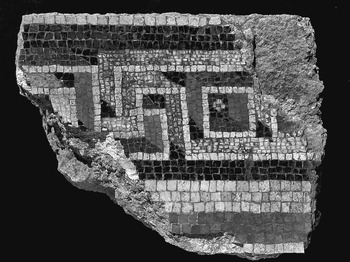
5.3. Meander border from Tel Dor, Israel.
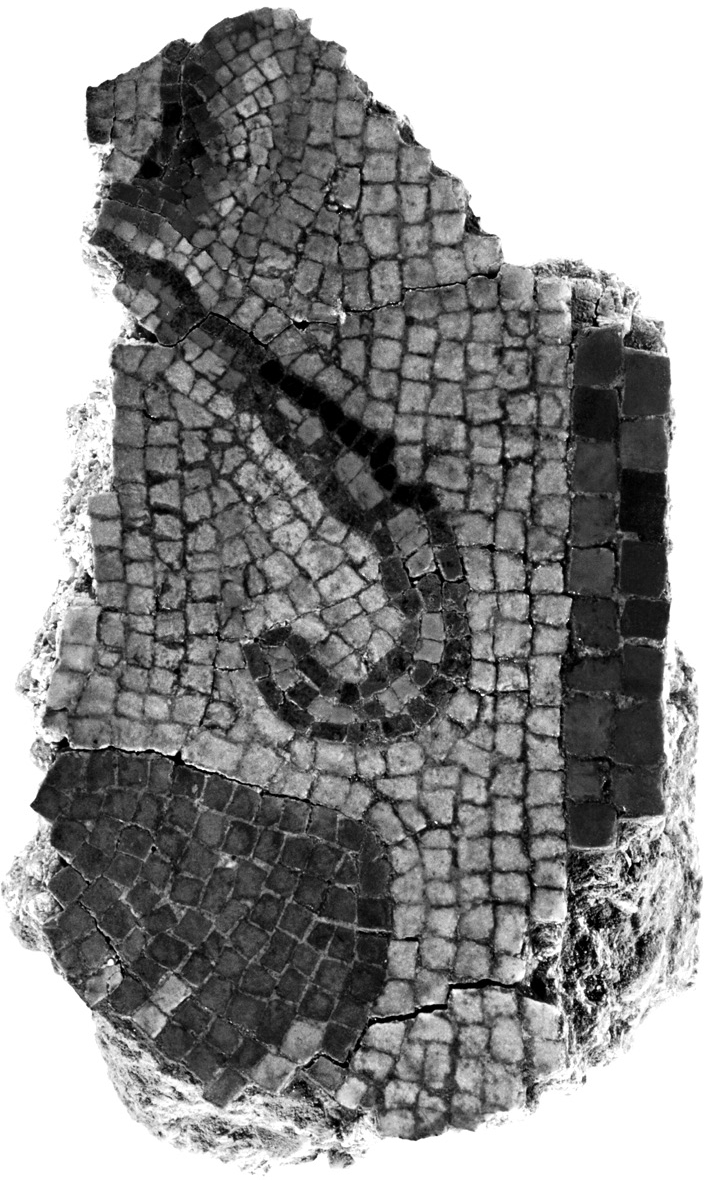
5.4. Central figurative scene of mosaic from Tel Dor, Israel.
The mask itself can be dated by type. It combines features of two mask types of New Comedy described by Pollux (Onom 4.147) and assigned by Webster, Green, and Seeberg to their Period 3 (150–50 b.c.e.).58 A second mosaic fragment showing only a thin eyebrow and wavy strands of hair suggests the floor had at least two mask types.59 Inside the garland frieze was laid a perspective meander that, in turn, framed the central scene (Figs. 5.3–5.4). Just enough of the latter is preserved – a well-modeled pink forearm holding a lagobolon – to place it in the context of hunting in the wilderness. Alternating masks suspended from garlands, perspective meander, Dionysiac themes, the extensive use of glass and the varied framing devices fit the period.60 The floor’s best parallels come from Italy, Malta, Sicily, and Delos.61 Another comes from two similarly fragmentary floors from Canopus, one showing a garden and the other Nilotic scenes.62
Thanks to its fragmentary state, much can be said about the way that the mosaic was laid. Two separate areas of white tessellation from the adjusting border have been identified: one with orderly rows and another with erratically laid tesserae, typically found in less important areas or under couches in a dining room.63 Straight vertical edges were observable in the bedding of at least two areas of the floor in the meander and central field, probably evidence of wooden shutters used to hold the wet mortar in place while small sections of the floor were laid.64 In 2004, William Wootton performed binocular microscopy on several mortar samples taken from every major area of the floor.65 His analysis showed that terracotta, quartz, shells, and local sandstone (kurkar) fragments were used as aggregates (Fig. 5.5). In the central area, a thin band of kurkar was noticed running throughout the mortars. The shells are from a variety of Mediterranean species. The composition of all mortars conforms to the local biology and geology of Dor, giving no reason to suspect that any part of the mosaic was manufactured and imported from elsewhere. The mortars prove the floor was laid in situ.
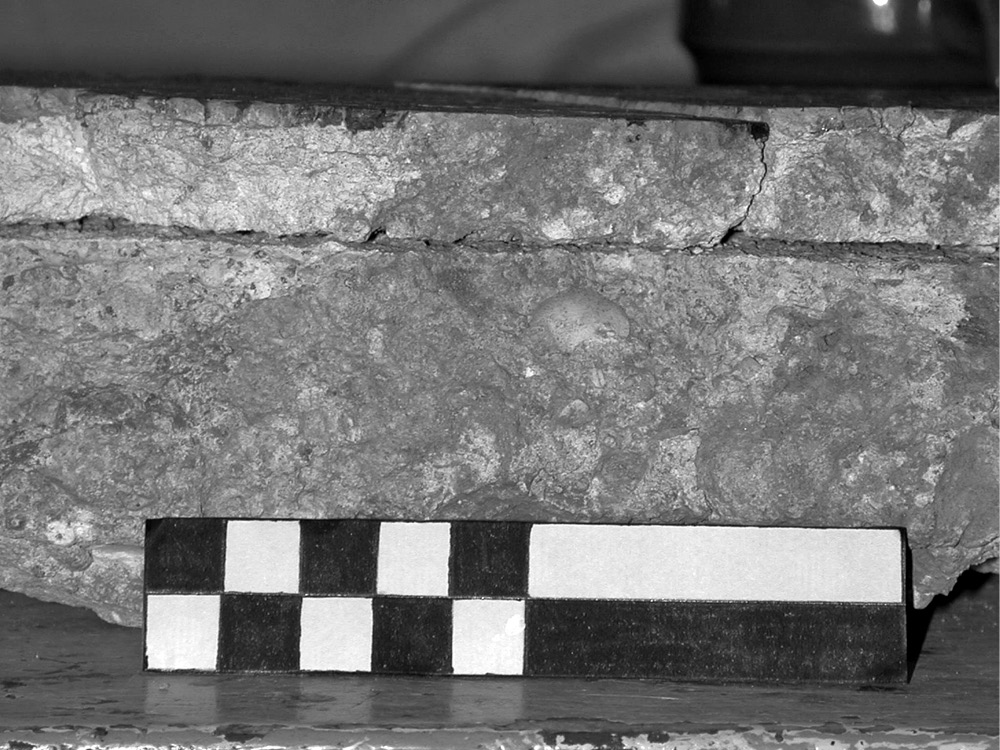
5.5. Bedding of mosaic from Tel Dor, Israel.
Since no contemporary vermiculatum or even polychrome mosaics are known from the site or surrounding towns and cities, we may speculate that Dor’s mosaics were executed on commission – but by whom? The combination of the work’s high level of execution and the apparent lack of demand for it elsewhere precludes the conclusion that the mosaicist came from Palestine. The closest candidates are Antioch and Alexandria. Part of what makes Hellenistic Palestine interesting and challenging is its strategic location, on the one hand, and its subordination to neighbors to the south and north – the Ptolemies (r. Palestine 296–201 b.c.e.) and Seleukids (r. 200–104 b.c.e.) – on the other.66 The mosaic was laid at Dor probably during the period of Seleukid domination. In 139/8 b.c.e. the city endured a siege by Simon the Hasmonean, and later in the century it was seized by the tyrant Zoilos who also ruled nearby Straton’s Tower (Roman Caesarea). Possibly Alexander Jannaeus (r. 104–78 b.c.e.) took these cities from Zoilos in around 100 b.c.e.67 Hasmonean rule continued until 64/3 b.c.e., when Dor was granted autonomy and placed under the authority of the Roman governor (Jos. Ant. 14.4.4). The Dor commission required its mosaicist to travel some distance during a turbulent period.
The vermiculatum mosaic from Tel Anafa contributes valuable information to the discussion of this material, notably a secure archaeological context that provides terminal dates for its construction and destruction. Because it is so fragmentary, the mosaic poses some difficulties in reconstruction and interpretation. It has not been fully published, although its context, Anafa’s Late Hellenistic Stuccoed Building (Fig. 5.6), has been.68 Small mosaic fragments (Fig. 5.7) and thousands of loose tesserae were found in Room 10 of the building’s South Wing. The room measures around 5x6m, and material inside and above its clay ground floor dates to the late Hellenistic period. Construction of the floor is phased to the site’s Hellenistic 2A, or ca. 125 b.c.e. It was used throughout the life of the building until its abandonment and gradual destruction beginning sometime in the early first century b.c.e. The mosaic came from the second story of the building and was excavated in destruction debris that were lying on top of the clay floor and covered by the building’s roof and walls. Several large nails found in the rubble were used to support what was surely a heavy floor.
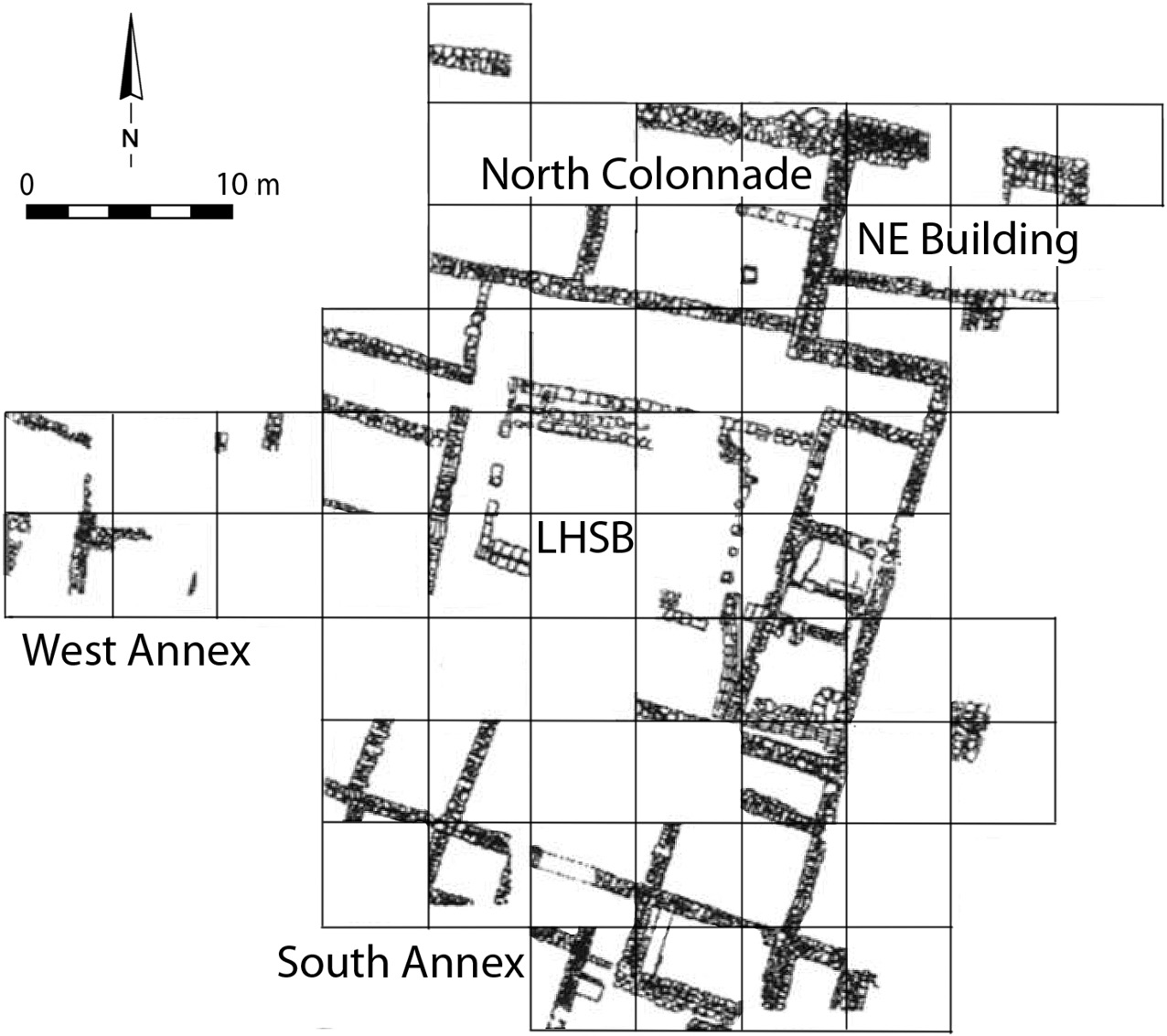
5.6. Plan of the Late Hellenistic Stuccoed Building (LHSB) from Tel Anafa, Israel.
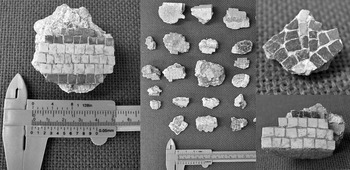
5.7. Fragments of opus vermiculatum mosaic from the LHSB, Tel Anafa.
From the fragments that could be studied first hand, the floor was divided into at least three areas: the irregular and regular plain white tessellation of the adjusting border, linear border devices, and a pictorial scene or frieze.69 Several of the fragments with irregular white tessellation show traces of wall plaster on one side, reinforcing the idea that they came from the edges of the room. All of the linear borders are rendered in white and blue; many of them show the effects of shuttering (Fig. 5.7, left and bottom right). Several fragments show other construction techniques similar to the Dor mosaic, including the use of aggregate – in this case, pebble – in the coarse mortars and a comparable depth of ultra-fine setting beds (Fig. 5.8). Without more invasive techniques, more cannot be said about the particular composition of the bedding.

5.8. Bedding of mosaic fragments from the LHSB, Tel Anafa.
The largest fragment from Anafa measures only 8.4x5.5cm. As a result of the mosaic’s fragmentary state, the content, composition, and location of the decorated area are impossible to reconstruct. Most pieces show characteristic curving lines of tightly laid tesserae in a variety of reds and blues with some yellow. Blue glass was detected in several fragments. Identifying the subject matter of such abstract fragments in isolation is virtually impossible, but juxtaposition with larger fragments is suggestive. For example, the pomegranates from Dor (Figs. 5.1–5.2) can be compared to a fragment showing a red object from Anafa (Fig. 5.7, upper right). The colors and technique are indistinguishable, virtually interchangeable. At least two Anafa fragments look remarkably like the hair from the masks at Dor. Probably the decorated area of the mosaic at Anafa was a vegetal scene comparable to the garland or central scene from Dor. Figures, masks and other elements may also have been present.
As a result of the overall similarity of style and construction technique, comparable quality, and sudden appearance of these vermiculatum mosaics in Palestine, it is plausible that the same artist executed both. The use of locally available material for aggregates in the mortars may be just one sign of the artist’s adaptability. Certainly patrons had input into the design, as well. There is some hint of such differences in the remaining fragments from Anafa, which generally employ a more restricted color palette than the Dor mosaic. Perhaps the polychrome area of the Anafa floor was smaller.70 The Anafa mosaic was executed sometime during the very short lifetime of the Late Hellenistic Stuccoed Building, between the fourth quarter of the second century and the very earliest years of the first. This date corresponds well with the one proposed for the Dor mosaic according to the mask type and stylistic parallels. Both floors were probably laid ca. 125–100 b.c.e., and thus offer us the remarkable opportunity to identify an individual artist who travelled to Palestine to produce mosaics in situ.
While there is ample evidence that many mosaicists travelled, travelling to work on commission is not the same as being an “itinerant artist.” Several scenarios present themselves for the Dor and Anafa floors. Both commissions could have been arranged before the artist arrived in Palestine. Another possibility is that only one was prearranged and the second commission was earned later. Finally, it is possible that neither was prearranged. Although an intriguing possibility, the sudden appearance of an itinerant artist in Palestine is hard to imagine unless artists were willing to travel far afield with no guaranteed income and little hope of lasting success. With work of this quality, formal training outside Palestine is assured. If we assume some sort of paradeigma was used, such as cartoons, it is worth noting that the floors are not identical to one another nor to any other known mosaics. With Hellenistic mosaics, however, the general rule is variation; even when their elements were conventional, mosaics were rarely, if ever, truly identical.71 For all the emphasis placed on the paradeigma, the Zenon papyrus seems to underscore this idea, as its aim is to adapt the model to a specific site. Further, even if the Palestinian commissions were prearranged, we do not need to imagine a scenario comparable to the Zenon papyrus; details of design could have been worked out on site. If the artist brought with him records of previous work, perhaps they resembled a modern portfolio – examples of good work that could be modified as desired – rather than a stock pattern book.72 The prestigious locations or high-status patrons of the artist’s previous work might have been important to his success in winning commissions. The Palestinian vermiculatum mosaics show that there is much to be gained from studying technique. The surface comparison of mosaic only allows us to go so far, whereas mortars contain a wealth of information about mosaic production independent of popular subjects and designs, contracts, or patrons. Detailed and scientific comparison of all the different parts of mosaic floors makes it possible to identify the hands of individuals with some confidence.
The Artist as Individual
We have looked for evidence of the mosaicist at the juncture of his work’s subject, style, and distribution and in the very fabric of his mosaic’s mortars. But the only way to name an individual artist is through textual evidence. Four extant signatures of three different mosaicists contain ethnics that might shed light on their identity. Assuming, for now, that one’s origin signals one’s ethnicity, two of these three artists are Greeks and both times their signatures appear outside of Greece. Dioskourides of Samos’s emblemata were found at Pompeii and Dionysios of Alexandria, son of Herakleides, signed a work in Sicily. What was important (if anything) about these signatures for artist or patron? Perhaps ethnicity itself mattered. Another possibility is that the patron’s status was increased not because of the artist’s origins per se, but rather because of how far the artist, or the work, had travelled. The remaining signature records the name of Asklepiades from the Phoenician city-state of Arados. Asklepiades signed a work of ca. 100 b.c.e. in the House of the Dolphins in Delos (Figs. 5.9–5.10).73 Thanks to the preservation of the House of the Dolphins, this example is especially enlightening.
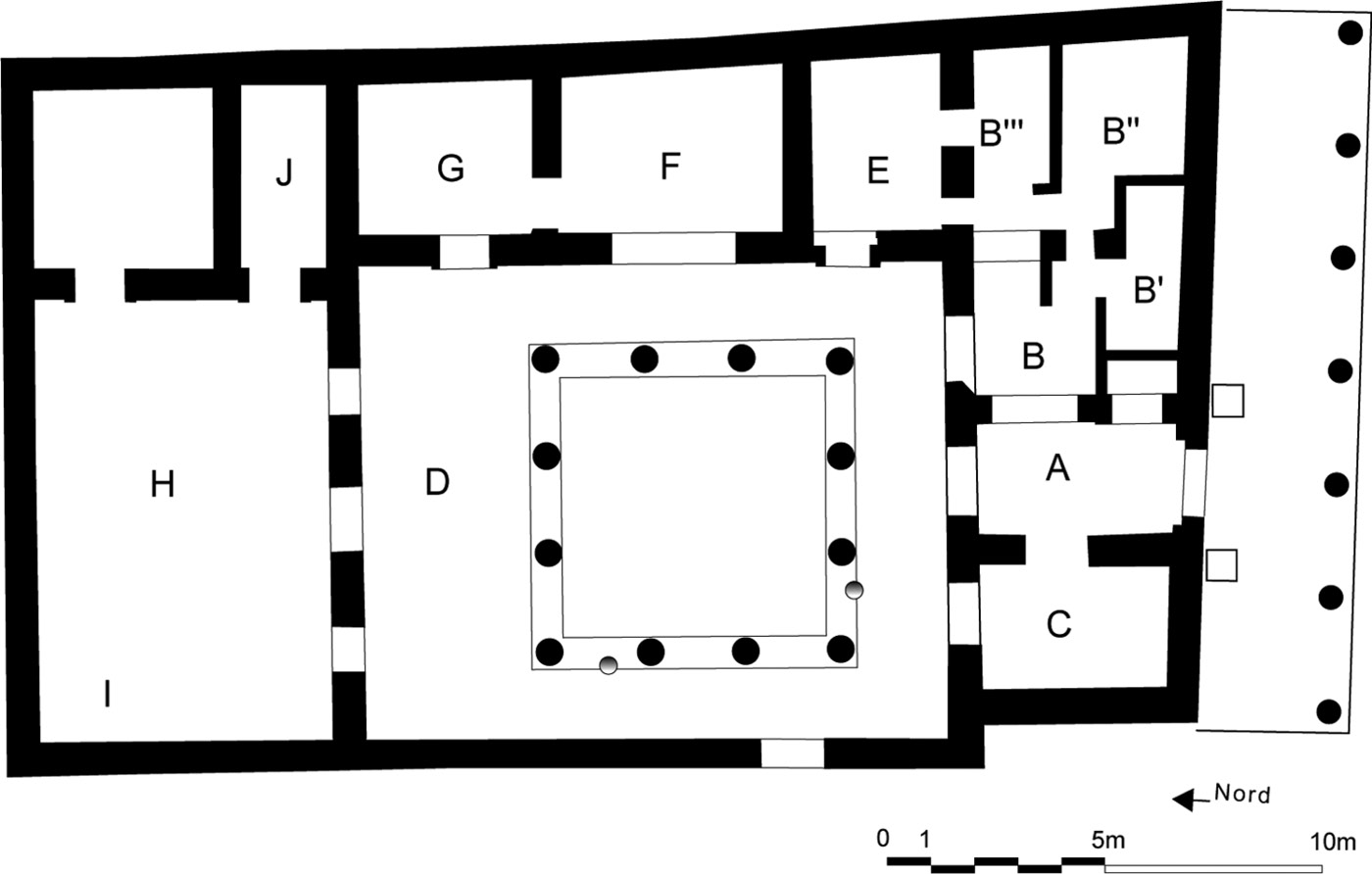
5.9. Plan of the House of the Dolphins, Delos.
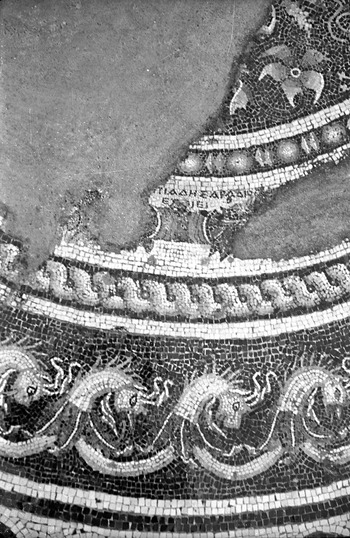
5.10. Signature of [Askle]piades of Arados from the House of the Dolphins courtyard mosaic, Delos; “D” on plan above, fig. 5.9.
The house’s eponymous mosaic is found in its courtyard. The decorated area is surrounded by the peristyle and sunken, as an impluvium. The floor is framed by a series of black, white, and red rectangular bands and crenellations. At the floor’s center is a series of circular bands and patterned areas including crest waves, meander, guilloche, astragal, and a marine-inspired tendril, all surrounding a rosette. In each “pendentive” zone – the four triangular areas formed between the central circle and its rectilinear frame – is an Eros riding a dolphin and leading a second on the rein. Most of the floor is worked in opus tessellatum, but the erotes and dolphins are vermiculatum. The fragmentary inscription lies between two of the patterned circles: [ΑΣΚΛΕ]ΠΙΑΔΕΣ ΑΡΑΔΙΟ[Σ] ΕΠΟΙΕΙ. The signature of a Phoenician artist merits comment in itself, but it becomes especially interesting when we recall that the house’s vestibule contains the black and white sign of the Phoenician deity Tanit (Fig. 5.11).74
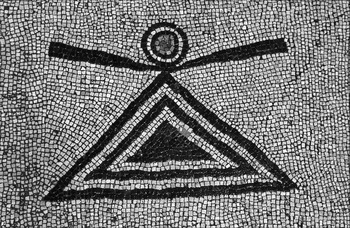
5.11. Sign of Tanit from the entry to the House of the Dolphins, Delos; “A” on fig. 5.9.
The iconography of the vestibule mosaic identifies the patron as Phoenician. Possibly, in this case, artistic ethnicity was important to the patron – a Phoenician homeowner deliberately hired a Phoenician mosaicist. Even if so, we cannot claim that ethnicity had any bearing on the house’s famous courtyard mosaic. Nothing about the courtyard mosaic’s virtuoso quality or Hellenic iconography suggests that the patrons or artist were Phoenician. Indeed Asklepiades’s work is indistinguishable from that of Dioskourides. Lacking the ethnic “of Arados,” Asklepiades would be presumed Greek, and, without the vestibule’s reference to Tanit, the patron might have been viewed as Greek, too, or at least “fully Hellenized.” The House of the Dolphins underscores the danger of assuming that iconography, and even style, are good indicators of an artist’s ethnicity. We must accept that many mosaicists, even those like Asklepiades who produced some of the genre’s finest works, were not Greeks. The artist signature in the House of the Dolphins proves that the work of non-Hellenic mosaicists was acceptable. Perhaps it was even unremarkable.
The deployment of Greek iconography and style, the exclusive appearance of Greek in artists’ signatures, and the pro-Greek perspective of mosaic’s one appearance in literature, have contributed to the idea that picture mosaics were invented and made by Greeks. Yet the “Hellenic identity” of mosaic cannot stand: there is no direct continuity between Greek pebble mosaics and tessellated ones; Hellenistic centers at Delos, Alexandria, and Pergamon were not populated by clear-cut groups of innovative Greeks and artistically hapless natives; the appearance and popularity of mosaics in Sicily and Italy cannot be explained only or always in terms of acculturation and Philhellenism; and we cannot, with our current knowledge, propose meaningful or direct connections between Greek iconography, technique, and an artist’s origins.
Conclusion: The Eastern Mediterranean Perspective
These mosaics have a role to play in our histories of Greek art. Identifiable Hellenic elements are in play. But, at the same time, we need not assume that Greek artists were the progenitors or greatest innovators of this art form; Punes, Sicilians, Italians, Anatolians, Levantines, and Egyptians made clear contributions.75 Nor were Greeks always the genre’s best patrons. Many fine mosaics have had a role in the histories of these other regions. The continuing perception of picture mosaics as a hallmark of Hellenism stems from a present-day elevation of iconography, style, and literary evidence, such as it is, over other factors. This situation is familiar to those who study the concept of “Hellenization.” Picture mosaics raise some old questions regarding ethnic identity in the successor kingdoms and in cities like Delos and Morgantina. Their study has the unexpected effect of underscoring the importance of major centers, such as Alexandria, while also drawing into the discussion of eastern Mediterranean art areas that might otherwise be disparaged as the cultural periphery, such as Palestine. Mosaics raise other fundamental questions about whether or not the use of Greek is an indicium of acculturation: is the fact that Asklepiades wrote in Greek more important than the fact that he was from Arados? Indeed, mosaics make us question if the “Hellenistic period” is a modern description of a political epoch or if it was a cultural phenomenon in which the eastern Mediterranean became increasingly Greek in a conscious fashion.76
The problems with answering such questions are many. Their answers hinge, in part, on how we interpret the reception of these works, a task that must be completed without substantial literary views to guide us. It is equally plausible, for example, that the Dor and Anafa mosaics are evidence of emulation, appropriation, or something unanticipated by Helleno-centrism. While they may have signaled class or status that depended on the perception of mosaic as “Hellenic,” they may have sent a different kind of status-raising message as a result of their cost. Perhaps the mosaics themselves signal participation in a greater Mediterranean environment that, as I have argued elsewhere regarding Attic imported pots, did not require them to be recognized foremost as Greek products.77 While we should not assume all mosaics were patronized for the same reason, and while mosaics did serve practical purposes (Vitr. De arch. 7.1), conspicuous consumption would seem to be a key impetus. Ruth Westgate has argued that a greater square area was used for entertainment in Hellenistic homes than in their counterparts from the Classical period. One result was the appearance of decoration in more rooms, especially those suited to receiving guests, with the corresponding likelihood that greater numbers of people saw their decoration.78
Caution should be taken in equating status markers with “Greekness” in cosmopolitan environments such as Delos. Likewise we should be wary about assuming that mosaic was valued for something perceptibly Hellenic in more remote locations like Anafa. Not all luxury was Greek, certainly not in the Near East. Indeed, in this eastern Mediterranean milieu, some activities that we tend to associate with Greeks were not only derived from still more ancient Near Eastern traditions, but also existed in parallel with ongoing Near Eastern practices. Thus it is quite possible that opus vermiculatum mosaics did not read as “Greek” to consumers. This conclusion runs counter to the convenience of modern scholarship in that it presupposes that ancient craft was tied to ethnicity and that an object’s defining characteristic was a quasi-national identity. For many people in the Hellenistic eastern Mediterranean, not least of all Greeks and Phoenicians of places like Dor and Anafa, this kind of “nationalism” was either totally alien or subordinate to local identities. The signatures themselves remind us of this point: “of Alexandria,” “of Samos,” “of Arados.” Viewed in this light, the mosaics can say “like the royal court,” “from a distant island,” or “by an artist from our homeland.”79 Like the mosaics themselves, the signatures may not be expressing the objective ethnic identity of an ancient artist or patron, but rather civic or social identities particular to context.
Mosaics might have had many meanings for their patrons, only one of which was the perception of the craft’s origins. A specific ethnic component could have been unimportant relative to the strong connections that gave rise to tessellation, spread tessellated and vermiculatum mosaics far afield, and helped shape the cosmopolitan Mediterranean perspectives of which they were a part. Even in keeping with traditional views of artistic personality, we can thus understand mosaic craft as more than a mere byproduct of Greek painting and use what we know of mosaic and its makers to begin writing the history of eastern Mediterranean art.



